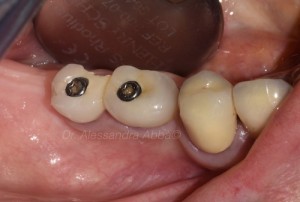
Adhesive or conventional luting for single crown cementation ?
Lorenzo Breschi
Nowadays, the material of choice for single tooth full crowns restorations are lithium disilicate ceramic and zirconia. Both materials are very popular and could be veneered with feldspathic ceramic or used as a monolithic restoration, offering many different and equally efficient approaches to restore posterior as well as anterior teeth. However, as regards cementation the use of an adhesive based approach or a conventional cementation protocol is still a controversial issue.
Adhesive resin cementation, as shown in different in vitro studies, could increase the retention and the fracture resistance of lithium disilicate crowns and improve the fatigue resistance of zirconia crowns. However, it involves a technique-sensitive, multi-step procedure that could be problematic in the case of subgingival crown margins or when the intraoral conditions cannot be controlled adequately. In these cases conventional cementation may be considered an acceptable alternative to adhesive cementation, being less clinically demanding.
MATERIALS AND METHODS
A recent systematic review, authored by Maroulakos G. and his team, analyzed the clinical performance of tooth-supported ceramic crowns and described the complications/failure characteristics when adhesive or conventional cementation was employed. 2571 relevant studies published between 2008 and 2018 were identified using several electronic databases.
RESULTS
From the titles yielded, only 17 articles met the eligibility criteria and were included into the qualitative analysis. The analysis reported that the survival rates for adhesively cemented lithium disilicate crowns ranged from 83.5% to 100%, whereas the survival rate reported for conventionally cemented lithium disilicate crowns was 98.5%. Survival rates for adhesively cemented zirconia crowns ranged from 83.3% to 100%, whereas those reported for conventionally cemented zirconia crowns ranged from 82.0% to 100%.
The most common complication reported for zirconia crowns was mechanical and involved fracture of the veneered ceramic both for adhesively cemented and conventional cemented crowns. This complication could be related to the thickness of the veneer, the design of the zirconia core, or the core-veneer thickness ratio and may not be related to the type of cement.
CONCLUSIONS
The authors conclude that, based on current evidence, adhesive and conventional cementation results in comparable clinical outcomes for both lithium disilicate and zirconia tooth-supported single crowns.
For additional informations:
Effect of cement type on the clinical performance and complications of zirconia and lithium disilicate tooth-supported crowns: A systematic review. Report of the Committee on Research in Fixed Prosthodontics of the American Academy of Fixed Prosthodontics
 Related articles
Related articles
Digital Dentistry 25 July 2022
Digital approach to replicate aesthetic and functional parameters in complete implant rehabilitation
Authors: C. Monaco, N. Ragazzini, L. Card, E. Evangelisti
The introduction of digital technologies in implant-prosthetic dentistry has allowed an improvement in the predictability of clinical results, the reduction...
Prosthodontics 23 May 2021
The clinical success of three-unit fixed prosthetic restorations in zirconia with 14-year follow-up
Zirconia (ZrO2) is a high-strength polycrystalline ceramic and is considered a suitable material for single crowns (SC) and fixed multi-unit dental prostheses (FDP), as it tolerates higher occlusal...
Prosthodontics 29 September 2020
Fixed dental prostheses: which is the gold standard material?
Metal ceramic has always been the golden standard for implant‐supported reconstructions in the past and the most investigated material in literature,...
Prosthodontics 12 February 2020
Which is the best adhesive cementation protocol for glass ceramic restoration?
Dentists must regularly determine the best adhesive cementation protocol for glass-ceramic restorations on posterior teeth. A few in vivo follow-up...
Prosthodontics 23 October 2019
Rehabilitation of endodontically treated molars: is better to choose endocrown or crown with post?
The restoration of endodontically treated teeth is always a topic of crucial attention for dentists. If until a few years ago, the therapeutic choice of...
 Read more
Read more
Editorials 10 October 2025
With proud smiles and crisp white coats, ninety-three learners from the DDS Class of 2029 and the International Dentist Pathway Class of 2028 marked the start of their dental careers at the UCSF...
Periodontology 10 October 2025
Continuous professional development (CPD) in Periodontology refers to the overall framework of opportunities that facilitate a life-long learning practice, driven by the learner-practitioner and...
TheraBreath, the #1 alcohol-free mouthwash brand in the U.S.*, has introduced a new line of dentist-formulated, clinically tested toothpastes designed to support professional oral care...
News 10 October 2025
New officers and trustees were installed at the Minnesota Dental Association’s Leadership Conference on September 19 in Minneapolis.
News 10 October 2025
Smartee Denti-Technology today announced that Professor Gang Shen, its Chief Scientist and Executive President of TaiKang ByBo Dental, has once again been named to the World’s Top 2% Scientists...















